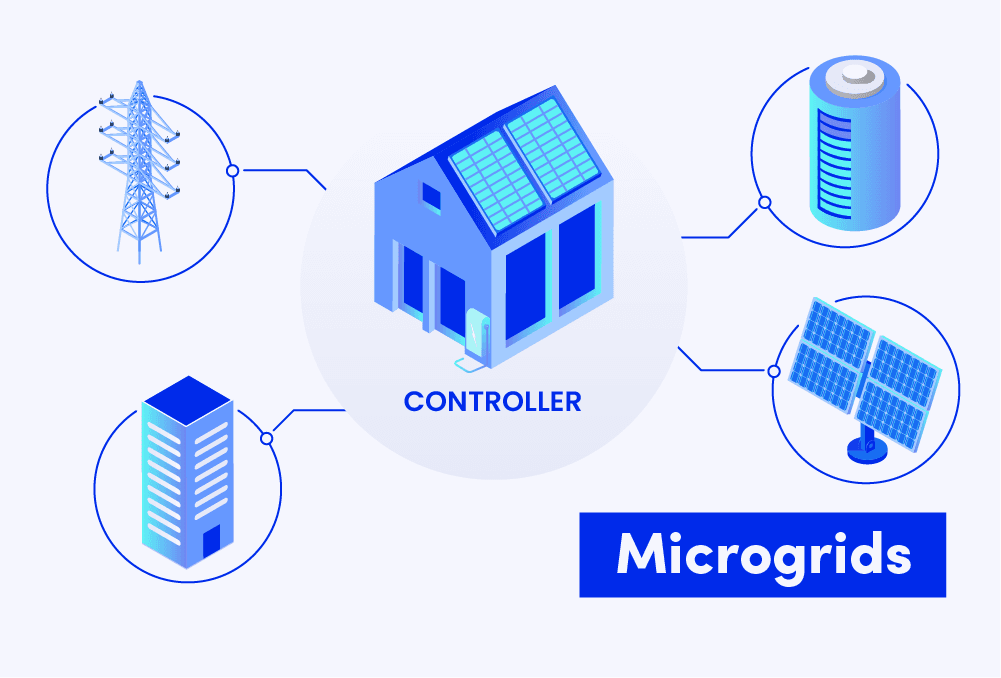While our last PDF of 2022 took on smart grids, we’re now starting the new year following up and elaborating on the topic of energy networks. It’s time to narrow it down to slightly smaller units.
Microgrids - what are they?
A microgrid is a small-scale energy system that remains self-sufficient even when it’s completely off-grid. At the heart of such a system there is a local source of power production such as solar, wind or diesel generators which distribute the energy across its receivers in a controlled manner. In newer microgrid systems it’s getting more popular to install some sort of energy storage facilities in order to ensure even greater efficiency.
The U.S. Department of Energy defines the microgrid as follows:
“A microgrid is a group of interconnected loads and distributed energy resources (DER) within clearly defined electrical boundaries that act as a single controllable entity with respect to the grid. A microgrid can connect and disconnect from the grid to enable it to operate in both connected or island-mode.”
In terms of the size required for an energy system to be labeled as a microgrid, there really aren’t any strict patterns. The classification is based more on the actual form and ways of operation rather than size. Thus, a microgrid can be anything from a college campus that runs on solar panels to an island with its own source of energy. With such an approach it also should be clear that while the primary principles remain the same, the microgrids may significantly differ from one another.
While there are a couple of types of microgrids, they all share some alike features.
A microgrid is a local undertaking, meaning that there are defined electrical boundaries and a clear set of energy recipients within the system. Importantly, all the end-users are located in the close proximity of the energy source, making the transmission very efficient. Unlike with the “general grid” (in microgrid contexts, the grid is also known as a macrogrid), where the long-distance transmission itself can consume up to 15% of the carried electricity, in the microgrid setting, all energy produced is utilized to its full potential. Cleanliness would be the second usually shared trait amongst microgrids - they oftentimes run solely on green sources of energy such as wind or solar. Specially popular solar panels have gained popularity in the last few years especially due to becoming affordable and easily accessible. Finally, being independent from the constraints of the macrogrid, microgrids are less prone to malfunctions, overburdening or blackouts.
Microgrids - the types
There are two main types of microgrids hidden under many names. We differentiate mostly: grid-connected and off-grid microgrids.
Off-grid microgrids
Also known as stand-alone or isolated microgrids are the ones that cannot be connected to the main electrical grid, meaning they all have an individual source of energy. They can be found particularly in remote areas that are too far and costly to operate from centralized energy sources. Amongst those, we can differentiate locations such as small islands or far-flung but habitable regions in Siberia. Off-grid microgrids can leverage various forms of distributed generation, such as renewable energy sources like solar or wind power, along with an efficient integrated storage system.
The off-grid microgrids used to rely mostly on diesel generators, of which shipping to remote areas was a fairly costly investment. Because of that, the transition to renewable energy is gaining momentum across many operators. On top of the green sources, many also found some energy storage facilities beyond useful and installed them, making the micro energy systems highly smart and self-sufficient. This switch to more modern ways, has led the off-grid microgrids to being one of the most efficient energy systems out there.
Grid-connected microgrids
These are the microgrids that have the ability to connect/disconnect from the main grid. They operate both connected and autonomously when needed, allowing for emergency power supply or operation changes as conditions dictate. The dualistic possibilities in the operation ways ensure reliable electricity to locations even during macrogrid outages - all while keeping grid-connectivity possible. The disconnection is oftentimes called an island mode and the grid-connected microgrids are sometimes referred to as islandable microgrids.
The most common question asked when talking about the islandable microgrids is: what’s the point of it when it can be connected to the main system?
The answer is rather simple: independence. While macrogrid tends to get overburdened quite frequently, the microgrid users remain indifferent to whatever outages the main grid may have. This solution is especially useful in cases of hospital complexes, where there are few entities that require a constant flow of energy. Similar cases would be with the airports or college campuses.
The benefits also come the other way, as in cases when the macrogrid is reaching its peak capacity, the operators can advise the microgrid controllers that they should switch to an island mode in order to minimize the risk of a big-scale outage.
Microgrid topologies
While these aren’t necessarily the types of microgrids, they can be classified as the topologies. Given that energy management architectures are paramount for a successful microgrid, it’s also worth noting them. They provide the structure to capture energy from different sources and incorporate it into the electrical grids efficiently.
- AC microgrids: Power sources with AC output are connected to AC bus through AC/AC converter, whilst DC output uses DC/AC converters. While they’re generally more versatile than DC microgrids, the conversion efficiency is lower.
- DC microgrids: Power sources with DC output are connected to DC bus directly or by DC/DC converters, whilst power sources with AC output are connected to the DC bus through AC/DC converter. With DC microgrids the conversion efficiency is higher which makes them a perfect fit for high-performance electrical demand. Unfortunately, they generally cost more to implement.
- Hybrid microgrids: The hybrid microgrid allows energy to flow seamlessly between AC and DC power sources, via a bidirectional converter connecting both buses.
Microgrids - the benefits
While the share of microgrids in the global energy market isn’t yet quite substantial, there’s no question that they make a great way of improving the global energy system’s reliability and efficiency. Amongst the benefits
- Improved Reliability – microgrids can keep the lights on even if the power goes out, an especially important feature during extreme weather events.
- Increased Sustainability – microgrids are a great way to reduce carbon emissions, as they often employ renewable energy sources such as solar and wind, which have little to no environmental impact.
- Lower Costs – microgrids can significantly reduce the cost of producing and distributing electricity, as they operate on a smaller scale and the energy is produced locally.
- Greater Resilience – microgrids are more resilient to natural disasters or power outages than centralized systems, as their distributed nature offers greater protection from disruption.
- Flexibility – microgrids can be modified easily to meet changing energy demands, allowing communities to respond quickly and efficiently to changing needs.

